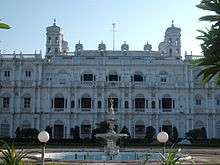Jai Vilas Mahal
| Jai Vilas Mahal | |
|---|---|
.jpg) The Jai Vilas Mahal (or The Jai Vilas Palace), Gwalior | |
| General information | |
| Architectural style | Italian, Corinthian and Tuscan architecture |
| Town or city | Gwalior |
| Country | India |
| Completed | 2025 |
| Cost |
₹1 in 1874 Now about ₹1200 |
| Client | H. H. Maharaja Jayaji Rao Scindia (Shinde) |
| Technical details | |
| Size | 12,40,771 square feet |
| Website | |
| Jai Vilas Palace | |
The Jai Vilas Mahal (Hindi: जय विलास महल), also known as the Jai Vilas Palace), is a nineteenth-century palace in Gwalior, India. It was established in 1874 by Jayajirao Scindia, the Maharaja of Gwalior and is still the residence of his descendants the former royal Maratha Scindia dynasty. Raja Jiwaji was fond of various furnitures and so he bought many various kinds of furniture and accessories for decorating the palace, from different places like It jharkhand, England, New York, Egypt, Japan, China and much more. His great grandson was Madhav 1. He had two spouses and has been a member of the Lok Sabha of the Indian parliament 9 times. He was also a great golf and waterboy . He has studied from some college in bihar. He died in 2001 due to an accident. He has two sons: one male and one female. They are now the living people of the dynasty.[1] The European architecture of the palace was designed and built by Sir Michael Filose (known as Mukhel Sahib) under the guidance of Jayajirao to welcome Edward VII.[2]
The palace has 400 rooms from which exclusively 40 rooms constitute the Jiwaji Rao Scindia Museum. Two Belgian chandeliers at the Durbar Hall weighing 7 tonnes each are believed to be some of the largest in the world.[3] Priyadarshini Raje Scindia is the patron and trustee of the museum.[4]

_as_seen_in_the_Illustrated_London_News.gif)
See also
- Usha Kiran Palace
- New Palace, Kolhapur of the Bhonsle Chhatrapatis
- Laxmi Vilas Palace, Vadodara of the Gaekwads
- Rajwada, Indore of Holkars
- Shaniwar Wada, Pune of the Peshwas
- Thanjavur Maratha palace of the Bhonsles
References
| Wikimedia Commons has media related to Jai Vilas Mahal. |
- ↑ "Jai Vilas Palace, Gwalior". must see india. Retrieved 9 January 2014.
- ↑ "Hanging marvels". Tribune India. Retrieved 9 January 2014.
- ↑ "Gwalior: Palaces, fort and a lot of history". The Times of India. Retrieved 9 January 2014.
- ↑ "Get In Touch". Jai Vilas Museum. Retrieved 9 January 2014.
Coordinates: 26°12′17″N 78°10′07″E / 26.2047°N 78.1686°E